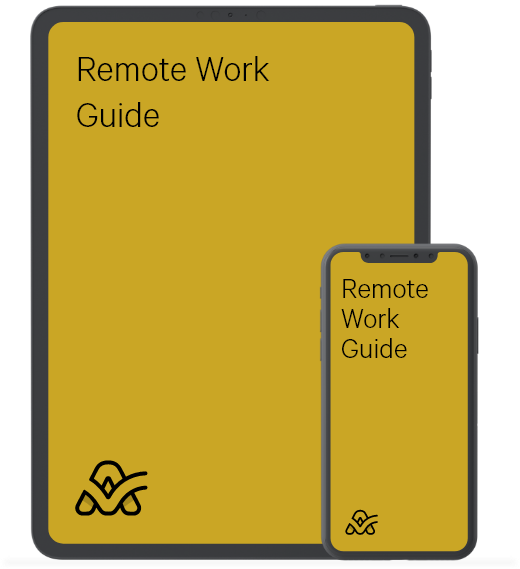Guest post by Dmitri Leonov from SaneBox.
Over the past few months, we’ve observed a quick transition to remote work amid the COVID-19 pandemic. Unsurprisingly, this sudden change was a shock to those accustomed to working in a physical office, some employers feared that maintaining team productivity would be a challenge. However, what we all should really be concerned about in this strange time is a longer-term consequence - burnout.
Here at SaneBox, we’ve been operating as a distributed company for many years now. We have team members all over the country, and it works for us. We love the freedom that comes with working from anywhere, as well as the ability to be flexible regarding our schedules. But, there are drawbacks to every seemingly great situation. The biggest, in my opinion, being work-from-home burnout.
The increase in burnout can be attributed to the lines between work and non-work blurring in new and strange ways. Since the home has replaced the office, it can be hard to preserve healthy boundaries between our professional and personal lives. Our work is always right in front of us, and working time will inevitably blend into time that used to be spent relaxing or doing any type of leisure activity.

Instant Messaging Cheat Sheet
Research suggests that drawing lines between our professional and personal lives is essential, especially for our mental health. But, even in the best of situations, it’s easier said than done. The knowledge economy has created an ideal that an employee must always be “on” and connected digitally.
So the question is - how can employees compartmentalize their work and personal lives to protect themselves from overt stress and burnout? As a seasoned remote worker who often works from home, I have some tips to hopefully help you cope with this new normal. Let’s dive in.
Maintain Boundaries In Your Home
A paper put out by Arizona State University described the ways in which people separate the transition from work to non-work roles by the means of “boundary-crossing activities.” Getting dressed in work clothes, commuting to the office - these are social and physical indicators that change has occurred. You’ve converted from “home you” to “work you.”
Keeping up with this demarcation is certainly easier said than done, especially since we’re all stuck at home. However, there are still ways you can transition to “work you.” Get dressed every day, even if it’s out of pajamas and into sweatpants. Create boundaries with other people in your household, too. Try your best to kindly let your family members or roommates know that although you’re working from home, you’re still working.
You’ll get much more work done if you aren’t constantly being interrupted. Establish and communicate what your working hours are, and when you’ll have break times where you’re available to socialize. If you’re lucky enough to have an office door that closes, consider making a do-not-disturb sign to let others know not to knock.
We also recommend snapping on some headphones so you can filter out any potential noise going on in your home. Listen to music, coffee shop noise, or various types of ambient or white noise – whatever helps stimulate an ambiance to put you in a focused headspace.

Remote Work Guide
Stick To A Schedule
Since the typical 9-5 schedule has pretty much gone out the window, we need to find realistic work-time budgets that work best for us. For some of us, our biggest challenge in maintaining temporal boundaries comes in the form of new child or elder-care responsibilities during normal work hours. Even for those of us without dependents, it can be challenging due to the fact that our digital devices keep our work with us at all times.
As best as you can with your circumstances, I recommend creating a schedule that works the best for you. Included in this task is deciding when you’ll start and stop working, when you will take breaks, what your morning routine will look like, and so on. Just make sure to communicate to your coworkers what your schedule will look like. You can do this by creating intentional work-time budgets by setting an “out of office” reply to delineate what hours of the day you will work. Another way to communicate this to others is to frequently update your Slack status to show when you are taking a break or simply OOO. This will help your teammates know when to expect a response and set expectations for you and others.
Creating transparent temporal boundaries often depends on the capability to coordinate your time with others. Make sure you’re working with your coworkers and supervisors to structure and manage the pace of work to safeguard against burnout. Holding regular check-ins to assess progress may help keep everyone on the same page and prevent misunderstandings from happening. Through this transition, keeping a sense of normality is important to promote work/life balance.
Focus On Your Top Priorities
Now that water-cooler talk and random distractions from coworkers have likely decreased, now is the time to dedicate your energy to top-priority tasks and projects. While working from home, employees often feel obliged to project the image of productivity, which can encourage them to work on tasks that are more immediate than important. Research suggests this is counterproductive as time goes on, even though it may benefit productivity in the short term. Therefore, employees should pay attention to their most important work first, especially as they juggle family and personal responsibilities at home.
It’s essential to remember that working all of the time, even on your priority project, isn’t the answer to winning at remote work. According to these statistics, the average knowledge worker is only truly productive three hours every day, and these hours should be free of multitasking or interruptions. Even before the pandemic started, workers found it increasingly difficult to find three continuous hours to focus deeply on their essential work tasks. With work and personal boundaries being breached, employees’ time is now more fragmented than ever.
Personally, I use the MIT (Most Important Task) Technique to help me focus on what I need to get done each day while decreasing my chances of burnout. This method is all about focusing on what is truly essential. Rather than scrawling out an extensive to-do list and attempting to get it all done, determine the top three unquestionably essential tasks that you can laser focus on. The idea is that until these tasks are completed, you don’t do anything else. Once the top tasks are decided, they are scheduled first in your day. This method works well when used in combination with the time-blocking method because you can save your early hours for the most essential tasks before getting bombarded by distractions.
By utilizing the MIT Technique, you are basically guaranteeing productivity. James Clear is a fan, saying: “If you do the most important thing first each day, then you’ll always get something important done. I don’t know about you, but this is a big deal for me. There are many days when I waste hours crossing off the 4th, 5th, or 6th most important tasks on my to-do list and never get around to doing the most important thing.”
You Don’t Have To Be “On” All The Time
It’s hard not to feel like you need to be “on” all the time as a remote worker. After all, work lives on your laptop, and your laptop is likely always in plain sight. However, you are at a high risk of burnout when working from home, and in the long-term, trying to squeeze in work whenever you can will stress you out immensely. We all need to find new ways, and help our coworkers along the way, to carve out personal time and mental space to just relax and take a break. We deserve it, after all!
These are just a few of my top recommendations that remote workers may find helpful to maintain boundaries between their work and personal life. I hope they help you avoid burnout in these already stressful and unpredictable times. Have some ideas of your own to prevent burnout? Tweet us @SaneBox and @ActiveCollab.
This post was brought to you by Dmitri Leonov, VP of Growth at SaneBox.
Dmitri Leonov is an internet entrepreneur, leading growth efforts at Sanebox. He has over 10 years of experience in startups, corporate strategy, sales strategy, channel development, international expansion, and M&A.



